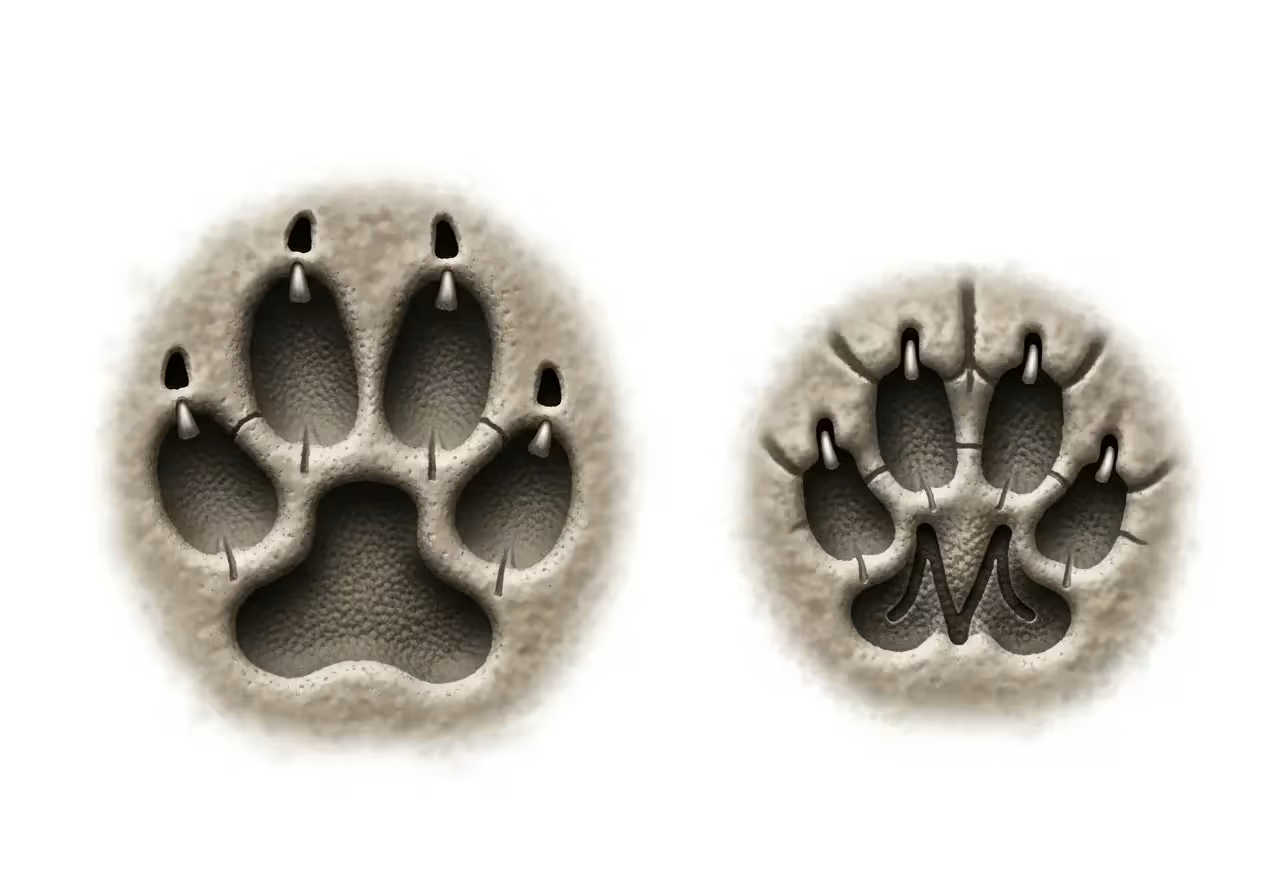
Reading the Clues: The Four Fundamentals of Track Identification
Identifying an animal track is like solving a puzzle with four key pieces. When you find a print, resist the urge to immediately guess. Instead, work through these four fundamental questions methodically. This process will help you narrow down the possibilities and make a much more accurate identification.
1. Count the Toes
The number of toes that register in a print is one of the fastest ways to place an animal into a broad category. While not all toes may show up in every print, especially in hard ground or shallow snow, the general pattern is a powerful clue.
Four Toes (Front and Hind): This is the hallmark of the feline (cat) and canine (dog) families. If you see a print with four distinct toe pads arranged in an arc around a larger heel pad, you are likely looking at a track from a bobcat, house cat, coyote, fox, or domestic dog.
Five Toes (Front and Hind): Many mammals have five toes, just like humans. This group includes weasels, skunks, raccoons, opossums, and bears. Their prints often look more like a small hand, with long “fingers” or distinct toe pads clearly visible.
Four Toes (Front), Five Toes (Hind): This specific combination is characteristic of rodents and rabbits. Squirrels, chipmunks, mice, and cottontail rabbits all share this trait. You often see their tracks in pairs or groups of four as they hop or bound along.
Two Toes: These are the ungulates, or hoofed animals. The most common in North American backyards is the white-tailed deer, whose hoof leaves a distinct two-lobed, heart-shaped print.
2. Look for Claw Marks
After counting the toes, check for the presence or absence of claw marks. This is the single best clue for distinguishing between a wild cat and a wild dog.
Claws Usually Visible: Members of the canine family (coyotes, foxes, dogs) have non-retractable claws. Like our own fingernails, they are always out. You will almost always see small dots or triangular marks in the substrate just ahead of the toe pads. The claws on the two middle toes are often the most prominent.
Claws Usually Hidden: Members of the feline family (bobcats, mountain lions, domestic cats) have retractable claws. They keep them sheathed to stay sharp for hunting and climbing. As a result, their tracks are typically clean, soft-edged, and show no claw marks. The exception is when a cat is climbing a steep or slippery surface, or pouncing, when it might extend its claws for traction.
Let’s take a mini-example. Imagine you find a four-toed track that is about 2.5 inches long. If you see distinct nail imprints above each toe, your primary suspect is a coyote. If the print is the same size but has clean edges with no nail marks, you should be thinking bobcat.
3. Measure the Size and Shape
Size matters in tracking, but it can also be misleading without proper context. A print in soft mud can spread out and appear larger than it really is. This is why carrying a small ruler or even using a common object like a quarter or your car keys for scale in a photograph is crucial for accurate wildlife identification.
Measure both the width and the length of the track, not including the claw marks. Note the overall shape. Is it round like a cat’s? Is it oval like a dog’s? Is it long and finger-like, as with a raccoon? Or is it heart-shaped, like a deer’s?
This is where a good field guide becomes indispensable. Once you have the toe count, claw information, and measurements, you can compare your findings to a guide specific to your region.
4. Analyze the Gait or Walking Pattern
A single track is one letter; a line of tracks is a whole sentence. The pattern of the prints, known as the animal’s gait, tells you how it was moving and can be just as distinctive as the print itself. Look at the arrangement of several consecutive tracks to determine the pattern.
Walkers (or Pacers): These animals move with efficiency. They often place their hind foot directly into the print left by their front foot on the same side. This is called direct registering. It creates a neat, narrow, and seemingly straight line of tracks. Foxes are famous for this, as are bobcats and deer when walking calmly.
Waddlers: Wide-bodied, flat-footed animals like raccoons, skunks, opossums, and bears have a rolling, side-to-side gait. Their tracks will appear staggered, with the left and right feet landing apart from each other as they amble along.
Bounders (or Gallopers): Long, slender animals like weasels and mink move with a bounding motion. They push off with their front feet and bring their hind feet up to land in or near the same spot, often creating track patterns of two prints side-by-side or in a cluster. Rabbits and squirrels are also gallopers, but with a unique twist.
Hoppers (a type of Galloper): Rabbits and squirrels have a signature gait. They land with their smaller front feet first, and then their much larger, more powerful hind feet swing forward and land *ahead* of where the front feet were. This creates a distinctive pattern where two large prints are in front of two smaller prints.















